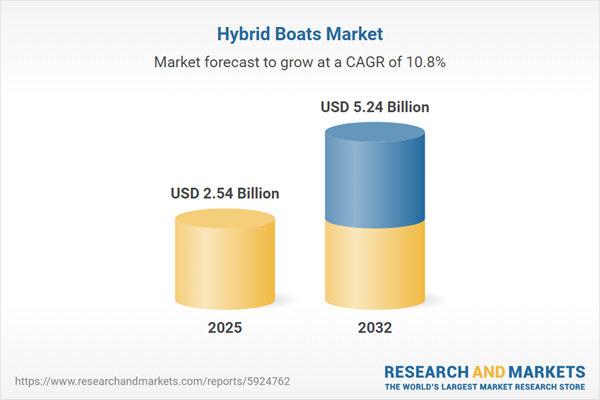Speak directly to the analyst to clarify any post sales queries you may have.
Hybrid marine vessels are transforming the maritime industry, offering cleaner, smarter alternatives for commercial, defense, and recreational operations. As operators look for solutions that align with sustainability mandates and operational efficiency, hybrid boats provide a compelling path forward.
Market Snapshot: Hybrid Boats Market Growth
The Hybrid Boats Market grew from USD 2.31 billion in 2024 to USD 2.54 billion in 2025, with robust expansion anticipated at a CAGR of 10.76% and a projected value of USD 5.24 billion by 2032. Strategic investment is being driven by accelerating environmental regulations, fuel cost concerns, and heightened demand for flexible propulsion solutions. Senior decision-makers face a rapidly changing landscape that requires informed approaches to hybrid vessel deployment.
Scope & Segmentation
- Propulsion Types: Parallel hybrid, regenerative hybrid, and series hybrid systems support a range of thrust, flexibility, and energy recapture functions.
- Boat Types: Cabin cruisers, catamarans, pontoon boats, and trimarans demonstrate diverse applications from leisure to utility.
- Hull Designs: Hydrofoil, multihull, and rigid inflatable structures optimize performance, fuel efficiency, and mission-specific capabilities.
- Material Choices: Aluminum, composite materials, and steel address weight, durability, and lifecycle cost factors.
- Size Segments: 20-50 ft, under 20 ft, and above 50 ft categories ensure adaptability for small crafts, mid-sized vessels, and large platforms needing bespoke integration.
- Platform Applications: Commercial boats, military and law enforcement boats, and recreational boats shape innovation priorities across sectors.
- Regional Markets: Americas, Europe/Middle East/Africa, Asia-Pacific highlight specific regulatory and infrastructural dynamics impacting adoption and investment strategies.
Key Takeaways: Strategic Insights for Senior Decision-Makers
- Hybrid marine technology is enabling vessel operators to meet stricter emissions standards while optimizing for operational cost and reliability.
- Advancements in battery energy density, digital monitoring, and modular powertrains are reshaping design approaches and enhancing system performance.
- Customer expectations are driving demand for lifecycle transparency, predictive maintenance, and service-based ownership models tailored for fleets of varying sizes and uses.
- Collaboration between propulsion system manufacturers, energy storage providers, and shipyards is strengthening supply chains and reducing integration complexity.
- Business models like battery-as-a-service and modular retrofit offerings are lowering barriers for fleet conversions and phased modernization programs.
Tariff Impact: Navigating Supply Chain Adjustments
Newly introduced tariffs in the United States have driven manufacturers to adapt sourcing and production strategies. These duties have prompted suppliers to diversify regionally, and operators are now managing procurement schedules and component standardization to mitigate added costs. The market is responding through vertical integration, strategic alliances, and adoption of tariff-exempt agreements to stabilize pricing and maintain operational predictability.
Hybrid Boats Market: Methodology & Data Sources
This analysis draws on primary interviews with senior executives, vessel operators, and technical experts, coupled with regulatory document reviews and field visits to major shipyards. Insights are supported by secondary research from industry reports and quantitative data modeling, alongside strict cross-referencing and data reliability protocols.
Why This Report Matters
- Enables actionable investment planning by providing current technology, material, and market adoption trends.
- Guides supply chain and procurement strategies with granular segmentation and regional analysis.
- Supports long-term fleet modernization and risk-management decisions in alignment with evolving policy and regulatory frameworks.
Conclusion
Hybrid boats are emerging as a critical solution for marine operators seeking sustainable, cost-effective vessel strategies. This report equips decision-makers with the insights needed to navigate technology adoption and capitalize on evolving market opportunities.
Additional Product Information:
- Purchase of this report includes 1 year online access with quarterly updates.
- This report can be updated on request. Please contact our Customer Experience team using the Ask a Question widget on our website.
Table of Contents
3. Executive Summary
4. Market Overview
7. Cumulative Impact of Artificial Intelligence 2025
Companies Mentioned
The companies profiled in this Hybrid Boats market report include:- AB Volvo
- BENETEAU SA
- Blazer Boats
- Blue Wave Boats
- Caymas Boats, LLC
- Cochin Shipyard Limited
- Crevalle Boats
- Ethos Boats
- Everglades Boats
- Falcon Bass Boats
- FRAUSCHER BOOTSWERFT GmbH & Co KG
- Grand Craft Boats LLC
- GreeNaval by Naval Yachts Co.
- Greenline Yachts by SVP Yachts
- Hybrid Boats
- Kerala State Inland Navigation Corporation
- Maverick Boat Group, Inc.
- NauticStar, LLC by Iconic Marine Group
- Navalt Inc.
- Rossinavi s.r.l.
- Savannah Boats
- Scout Boats
- Soel Yachts B.V.
- Solace Boats
- Torqeedo GmbH by Yamaha Motor Co., Ltd.
- Vexus Boats by Advance Marine Performance, LLC
- Wight Shipyard Co Ltd.
- Wärtsilä Corporation
- Yanmar Holdings Co., Ltd.
Table Information
| Report Attribute | Details |
|---|---|
| No. of Pages | 180 |
| Published | November 2025 |
| Forecast Period | 2025 - 2032 |
| Estimated Market Value ( USD | $ 2.54 Billion |
| Forecasted Market Value ( USD | $ 5.24 Billion |
| Compound Annual Growth Rate | 10.7% |
| Regions Covered | Global |
| No. of Companies Mentioned | 30 |









